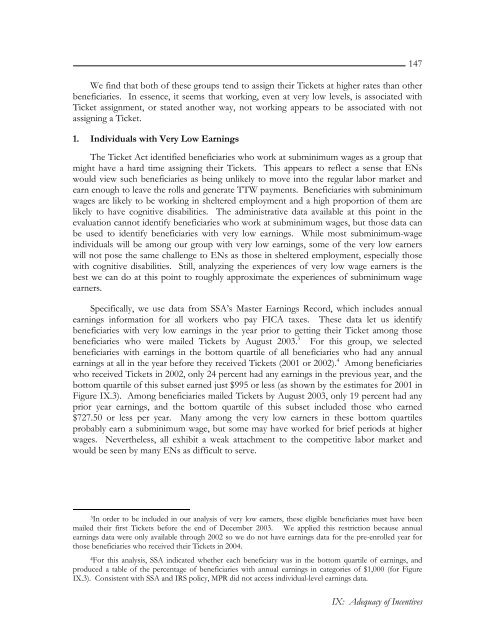Evaluation of the Ticket to Work Program, Implementation ...
Evaluation of the Ticket to Work Program, Implementation ...
Evaluation of the Ticket to Work Program, Implementation ...
You also want an ePaper? Increase the reach of your titles
YUMPU automatically turns print PDFs into web optimized ePapers that Google loves.
We find that both <strong>of</strong> <strong>the</strong>se groups tend <strong>to</strong> assign <strong>the</strong>ir <strong>Ticket</strong>s at higher rates than o<strong>the</strong>rbeneficiaries. In essence, it seems that working, even at very low levels, is associated with<strong>Ticket</strong> assignment, or stated ano<strong>the</strong>r way, not working appears <strong>to</strong> be associated with notassigning a <strong>Ticket</strong>.1. Individuals with Very Low EarningsThe <strong>Ticket</strong> Act identified beneficiaries who work at subminimum wages as a group thatmight have a hard time assigning <strong>the</strong>ir <strong>Ticket</strong>s. This appears <strong>to</strong> reflect a sense that ENswould view such beneficiaries as being unlikely <strong>to</strong> move in<strong>to</strong> <strong>the</strong> regular labor market andearn enough <strong>to</strong> leave <strong>the</strong> rolls and generate TTW payments. Beneficiaries with subminimumwages are likely <strong>to</strong> be working in sheltered employment and a high proportion <strong>of</strong> <strong>the</strong>m arelikely <strong>to</strong> have cognitive disabilities. The administrative data available at this point in <strong>the</strong>evaluation cannot identify beneficiaries who work at subminimum wages, but those data canbe used <strong>to</strong> identify beneficiaries with very low earnings. While most subminimum-wageindividuals will be among our group with very low earnings, some <strong>of</strong> <strong>the</strong> very low earnerswill not pose <strong>the</strong> same challenge <strong>to</strong> ENs as those in sheltered employment, especially thosewith cognitive disabilities. Still, analyzing <strong>the</strong> experiences <strong>of</strong> very low wage earners is <strong>the</strong>best we can do at this point <strong>to</strong> roughly approximate <strong>the</strong> experiences <strong>of</strong> subminimum wageearners.Specifically, we use data from SSA’s Master Earnings Record, which includes annualearnings information for all workers who pay FICA taxes. These data let us identifybeneficiaries with very low earnings in <strong>the</strong> year prior <strong>to</strong> getting <strong>the</strong>ir <strong>Ticket</strong> among thosebeneficiaries who were mailed <strong>Ticket</strong>s by August 2003. 3 For this group, we selectedbeneficiaries with earnings in <strong>the</strong> bot<strong>to</strong>m quartile <strong>of</strong> all beneficiaries who had any annualearnings at all in <strong>the</strong> year before <strong>the</strong>y received <strong>Ticket</strong>s (2001 or 2002). 4 Among beneficiarieswho received <strong>Ticket</strong>s in 2002, only 24 percent had any earnings in <strong>the</strong> previous year, and <strong>the</strong>bot<strong>to</strong>m quartile <strong>of</strong> this subset earned just $995 or less (as shown by <strong>the</strong> estimates for 2001 inFigure IX.3). Among beneficiaries mailed <strong>Ticket</strong>s by August 2003, only 19 percent had anyprior year earnings, and <strong>the</strong> bot<strong>to</strong>m quartile <strong>of</strong> this subset included those who earned$727.50 or less per year. Many among <strong>the</strong> very low earners in <strong>the</strong>se bot<strong>to</strong>m quartilesprobably earn a subminimum wage, but some may have worked for brief periods at higherwages. Never<strong>the</strong>less, all exhibit a weak attachment <strong>to</strong> <strong>the</strong> competitive labor market andwould be seen by many ENs as difficult <strong>to</strong> serve.1473 In order <strong>to</strong> be included in our analysis <strong>of</strong> very low earners, <strong>the</strong>se eligible beneficiaries must have beenmailed <strong>the</strong>ir first <strong>Ticket</strong>s before <strong>the</strong> end <strong>of</strong> December 2003. We applied this restriction because annualearnings data were only available through 2002 so we do not have earnings data for <strong>the</strong> pre-enrolled year forthose beneficiaries who received <strong>the</strong>ir <strong>Ticket</strong>s in 2004.4 For this analysis, SSA indicated whe<strong>the</strong>r each beneficiary was in <strong>the</strong> bot<strong>to</strong>m quartile <strong>of</strong> earnings, andproduced a table <strong>of</strong> <strong>the</strong> percentage <strong>of</strong> beneficiaries with annual earnings in categories <strong>of</strong> $1,000 (for FigureIX.3). Consistent with SSA and IRS policy, MPR did not access individual-level earnings data.IX: Adequacy <strong>of</strong> Incentives
















